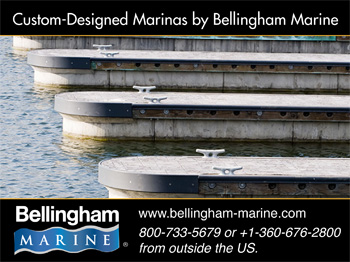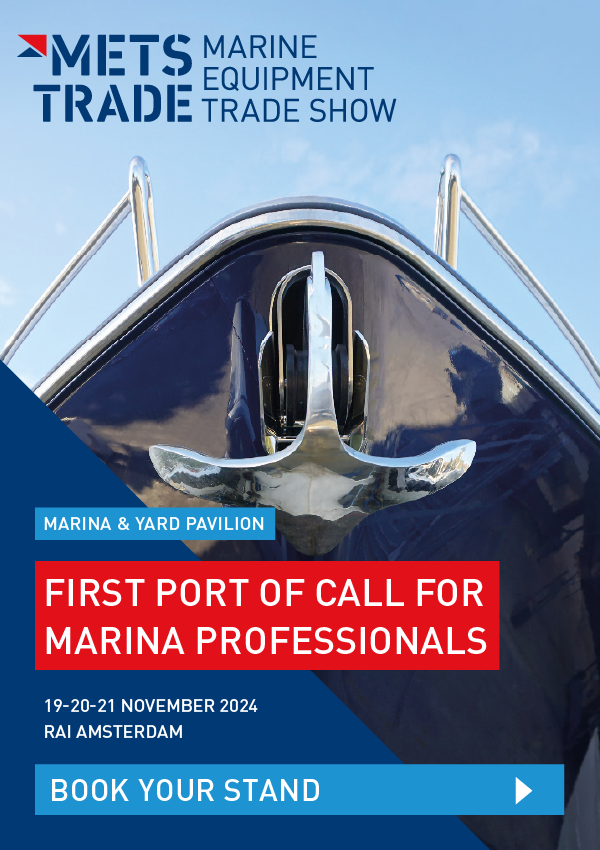Thorny problems – but a bright future
With the recent significant and ongoing rise in boat ownership, covered drystack is the most obvious solution to creating safe and secure boat storage in a world that is short of wet berths. Marina World asked industry experts how they thought the market was developing; what stumbling blocks existed; and whether they expected drystack to represent a noticeably larger slice of overall boat storage/mooring solutions in the future.
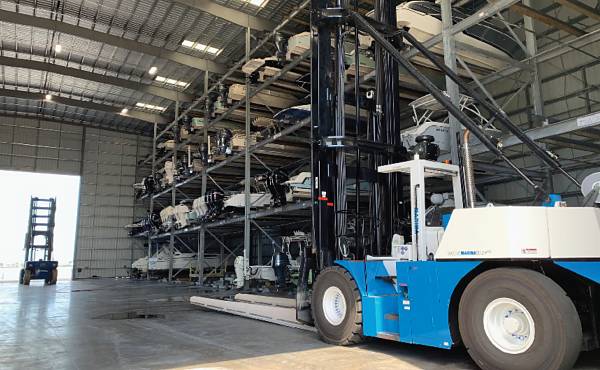
Mack David custom racking system looks good and maximises the use of rack space.
Development: Drystack is the solution for boats up to 5 tons/32ft (10m) in South America and Europe and up to 10 tons/43ft (13m) in North America and Australia, but the market for new drystack projects is not rising as fast as boat ownership. Basing our views on our team’s experience and conversations with clients, marina consultants, project owners and developers over the past ten years, we realise that markets, macro and micro, are also different and have different priorities. For example, we compare Europe with North America but Europe is not homogenous, e.g. drystack development is unlikely in Italy; there has been pioneering automation in France; and in Norway the focus is on winterising.
Obstacles: Permits take so much time, over five years and, according to some Americans, ten to 15 years, that investors may change the objective of the project, i.e. a drystack becomes a shopping mall…
Future growth: Yes. We think that because of the noise and odour-free eco-friendly electric solutions (stacker machines and new forklifts) the new generation drystacks will enable dry storage to be integrated into the community alongside housing, hotels, restaurants, offices and commercial areas. And preserve the most beautiful views close to lakes and oceans that will bring benefits to the community.
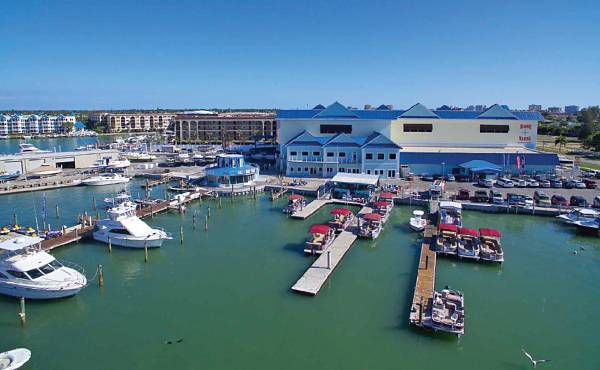
The design of Rose Marina shows how well thought out design can fit seamlessly into waterfront areas.
The market is evolving differently in terms of economic, physical and boat use conditions. But this evolution responds to common fundamental drivers.
Drystack facilities are a relevant element of a boating infrastructure system and can efficiently accommodate a potentially important share of the boats in a region. Their role within a regional system (described in PIANC WG 132) must be recognised in coastal/marine spatial planning, regulations and boating industry growth plans.
Fundamentally, drystack is an excellent solution for light motorboats under 10 or 12m (32 or 39ft) in length (including jet skis). This is especially convenient when there is a relatively high cost of waterfront land, scarcity of water space and high demand for small boats. This becomes critically important when the highest and best use of the water space in a marina is for berthing larger yachts. Therefore, as demand for berthing grows, a larger share of the small boat capacity is accommodated in dry storage; and as land cost increases, drystack becomes the preferred solution. For example, Pete Peterson (ATM) points out that the rise of larger and expensive centre consoles plays a huge role in the need for more drystack in Florida and some resort communities.
Where land is available in the short term, demand is weak and water level variations are low, surface storage and boat ramps are preferred. For example, drystack facilities are still uncommon in the Middle East, where the market is used to surface dry storage on trailers. Philip Slagle (ATM) notes that covered hard stand dry storage remains popular in the region given affordability. While drystack facilities may not be justifiable in the short-term, long-term planning requires their consideration to allow for the growth of boating without capacity ceilings. For example, drystack facilities in Mexico were built within the last two decades as part of master plans that allocated waterfront land for other real estate uses.
Within the drystack solutions, technologies for forklift based systems (more flexible) and crane systems (more space-efficient) have evolved over three decades (the fundamental concepts are also described in PIANC WG 132). Larger trucks and electric propulsion are now available for the operation of higher capacity forklift systems. After decades of technology improvements and limited projects built, crane systems appear to be achieving more popularity. For example, automated crane systems have been built in Florida and are being considered in Texas and in South Carolina, as well as for large scale new projects in the Red Sea.
In terms of stumbling blocks, some urban, tourism and real estate developers overlook the role of smaller boats and underestimate the value of drystack facilities. Some early adopters in new regions were built with drivers not fully established in the market and have not always performed as expected. This has reduced momentum. In the future, I expect the role of drystack facilities to consolidate.
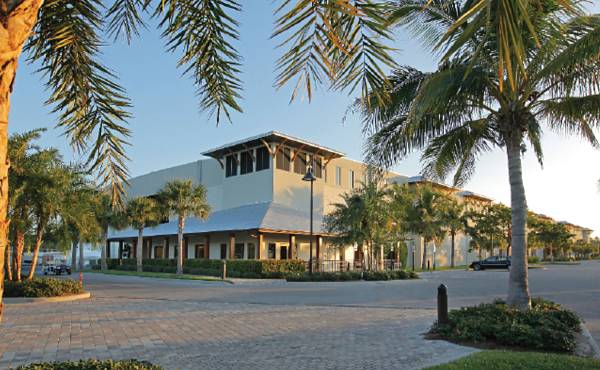
Hamilton Harbor Yacht Club, built in 2008, was the world’s first all-concrete dry storage barn.
Spinnaker International
Drystack berthing has been growing in popularity around the world, but it has not been as widely adopted in Asia. There are several reasons for this, including the historical promotion of boating as an elitist activity leading to a preference for larger boats. The effect of this is that many boat owners preferred their boats to be visible and easily admired, making wet berths more appealing than drystacks. However, recent developments suggest that this trend may be slowly changing.
A growing boating population has made boating activity perceived as less exclusive in many parts of Asia. The Covid pandemic has accelerated this trend as it drove a new demographic to the water, with younger boat owners eager to reconnect with nature and enjoy the great outdoors. This has led to an increase in demand for smaller boats, which has in turn brought new business to drystack facilities.
However, despite these positive developments, the lack of drystack developments in Asia remains a challenge. In most cases, marina development is driven by private enterprise, with many marinas being part of upmarket integrated developments. As a result, drystack facilities often lose out to alternative land use options that may be more economically viable or better aligned with the development’s aesthetic goals.
While efficiency of storage and sustainability are key drivers, developers should also explore new partnership models between public and private sector entities, as well as innovative architectural solutions that blend drystack facilities aesthetically into the development in a way that adds value to the overall offering.
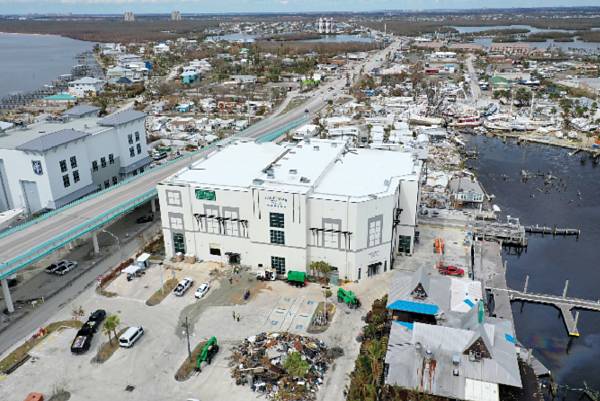
Gulf Star Marina in Florida proved its hurricane resistance when hit by the strongest storm surge and winds of Hurricane Ian.
Development: The drystack solution is clearly the most efficient way to maximise space, especially in overcrowded marinas, where a larger number of boats can be stored on the same space. In addition, each space that is released from the wet slips can be used for larger boats, generating greater profitability for the marina. In the last few months, we have been working on a number of projects around the world, both for marinas that want to reorganise their moorings and for new facilities that are planning to incorporate drystacks from scratch.
After the pandemic and due to the need to connect with enjoyment, the outdoors and recreational activities in general, many projects started up again and we are seeing significant activity in our sector, as in other outdoor-related sectors.
Obstacles: Projects for new marinas, as well as their refurbishment, take a long time to plan and are highly subject to regulation by the authorities. Drystacks are no exception to this reality, which means that decision-making takes a long time.
Inflation and interest rate increases, as well as the price of steel and other materials, together with rising labour costs, have led to an increase in investment analysis, but as drystacks involve a much more efficient use of labour and materials per boat unit, due to the incorporation of vertical moving equipment such as bridge cranes and shore elevators, we come out ahead in the investment analysis, with returns on investment in the order of 20 to 25%.
Future growth: The economic benefits for marina operators, the space efficiencies due to overhead storage, the user experience of 24/7 availability of boats in a matter of minutes, and the savings in wear and tear, ensure that we will see many drystacks in marinas in the coming decades.

Robert Brown
We are seeing several trends in the drystack market, including increasing demand in the central and northern United States where drystack has historically been less prevalent, and increasing interest in automated drystack facilities.
In particular, we are seeing a significant increase in demand for drystack storage across the Great Lakes region, which is in response to a number of factors. First, increasing environmental limitations on the expansion of existing and/or development of new wet slip facilities is limiting the ability to respond to market demand for either more wet slips or larger wet slips. In response, marina developers are trending towards building larger wet slips within limited developable areas and moving the smaller boats into adjacent drystack facilities. This allows the facility to greatly expand the number of slips it can provide at a much lower environmental impact, which further reduces permitting delays.

Max Brown
As boaters are moved from wet slips to drystack facilities, we have found it very helpful to provide more community gathering spaces within the marina to maintain the social aspects of marina life, such as fire pits, grills, play areas and restaurants.
Another trend driving demand for drystack facilities in northern climates is the simplicity of winter storage of the boats already in the racks, and the ability to use the aisles of the facility for supplemental winter storage. Many more boaters, in particular those with higher value centre console boats in the 35-45ft (11-14m) length value the additional protection from the elements. These facilities are also providing a much higher level of concierge service in terms of fuelling, maintenance, cleaning and provisioning that further increases profit margins.
Automated drystack facilities offer a range of benefits in the Great Lakes region, especially in areas where space is limited and there are concerns over emissions and noise from beeping, diesel-powered forklifts. All electric automated crane systems are quiet and reliable, and can stack larger and heavier boats on all levels of the facility for much greater efficiency and effective use of the interior volume of the structure. They can be taller, which allows for more boats in a smaller footprint, and can offset their demand for electricity through the use of solar panels on the rooftop. If sufficient battery back-up systems are employed, the facilities can continue to operate even during power outages.
While southern markets for drystack facilities are more mature, boaters in the northern and central US are beginning to see the benefits and marina owners are building more and more of them in response. The only major challenge is in the architectural design of the facilities, in particular in areas within historic maritime districts or other sensitive areas that require a high level of care in the design and detailing of the structures to avoid blocking views and negatively impacting the scale and character of the waterfront with a building grossly out of scale for its context.
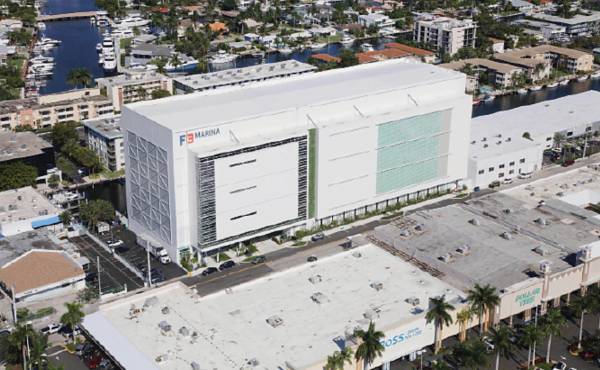
F3 Marina Fort Lauderdale has been built to resemble a 5-star hotel and is fully automated.
Development: Demand is definitely growing, and I see many marinas with waiting lists. With the need for marina drystacks increasing, the logistics of storing additional boats is changing the marketplace. Now more than ever, it is critical to obtain a market study to determine the likely boat sizes and general demand so as to plan for maximum capacity. Height restrictions and building size will dictate the most efficient storage - think usable space, not number of spaces. An empty rack is bad for business.

Alain Giudice
Obstacles: With well publicised storm damage, boat owners are also turning to more secure options for their storage needs. To support this growth, automated systems are becoming popular as well but, as they are relatively new to the market, the technology can be a great help but sometimes a hindrance. I am working on an automated/manual system where should the power fail, operations don’t have to stop. Upgrades in how we store boats are as important as improving basic marina storage operations. The quick release, adjustable bunker board system makes for more efficient operations as the bunk board can be adjusted with no tools necessary - it’s safer too.

John Matheson
Future growth: Absolutely. Robust outdoor racks are a worthy option as well, based on location. In places that are prone to hurricanes and other wind events, it is critical to go sturdy, and not skimp on costs. Centre-bolted, angled X bracing, and minimising the deflection of beams are two major considerations. The bottom line is that finding a builder who understands the big picture will make marina dry storage more profitable in the long run, and able to better accommodate future growth.

Monica Capria
The demand for drystack storage in the US is clearly on the rise and will likely continue to increase in the foreseeable future. This is due in part to the record pace of new boat sales over the past several years but also reflects an evolution in the way many people use their boats.
There is a preference to spend more time boating and diminish the effort to launch, clean and store a vessel particularly in Florida, the eastern seaboard and many inland lake marinas. Probably less so on the salt water marinas on the west coast due to the type of boats that are in that market. International interest has also grown, along with boating demand.
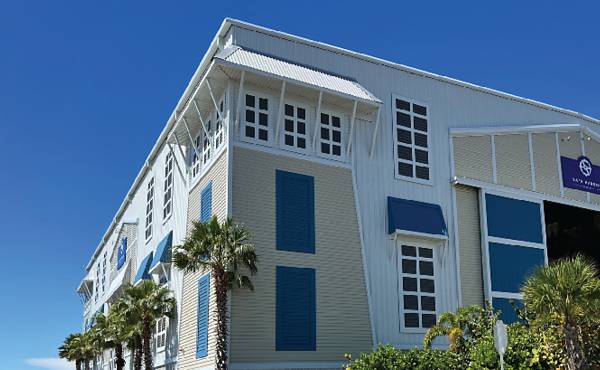
A Mack David designed drystack
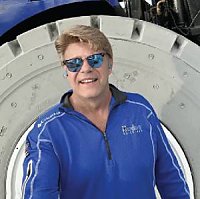
David Coyle
There is also a stigma with drystack structures creating strong opposition and a “not in my backyard” attitude. Finally, marina prices have skyrocketed in the past three years with many investment firms and developers jumping into the industry to take advantage of the nationwide growth in boating. This has driven marina prices higher making the margin for error very thin from a developer perspective.
Internationally, drystack demand has also increased along with the boom in new waterfront developments. The challenges here are similar to those in the US as waterfront sites are highly desirable locations and it is difficult to find available building land. The types of boat and boat usage vary significantly from region to region as well, and some locations do not demand drystack as much as others.
This does not mean drystack development will stop. Drystack developers that are persistent and possess the right formula can react to the current market realities and still be successful. At F3 Marina, we have overcome these challenges by perfecting the fully-automated drystack concept. An example is F3 Marina Fort Lauderdale, a fully-automated drystack located in the heart of Fort Lauderdale close to the ICW and Port Everglades inlet. The building is beautifully constructed to look like a 5-star hotel and has a quiet operation, enabling us to be good neighbours for condo developments directly across the canal.
Because of the automated nature of the structure, we are able to create density allowing us to build on expensive real estate and take up a smaller footprint than traditional drystacks with 250 slips on less than 1.5 acres (0.6ha). The automated concept can also be constructed away from the water such as behind a waterfront condo as long as there is about 30ft (9m) of access (either land or water).
Automated drystacks are very complicated and expensive structures to build. However, with the right team, they are the path to overcome the challenges of meeting strong and growing demand by boaters. It is our belief that drystacks will take an increased share of the market for boat slips in the coming years.
Max Brown and Robert Brown, ASAR
Development: Generally, a drystack marina serves to protect boaters’ investment while allowing them access to the water.
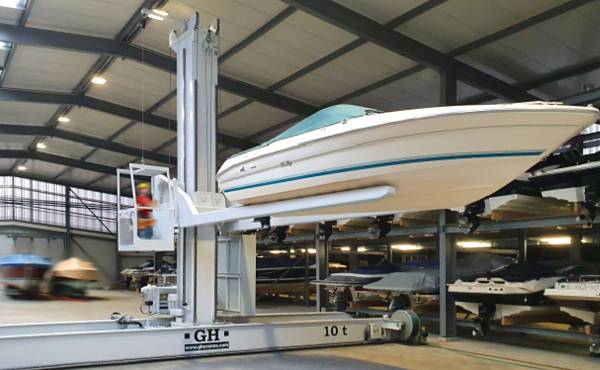
Drysta and GH Cranes worked together on their first European drystack project at Port Corsier in Geneva, Switzerland.

Greg Weykamp
On top of this, the use of concrete building materials has proven itself to be a safe haven from the elements, and even the threat of natural disasters. For example, Gulf Star Marina in Florida was hit by the strongest storm surge and winds of Hurricane Ian, yet did not lose a single vessel and only reported minor damage. On top of that, it was the first drystack marina fully operational and launching vessels, despite having been impacted directly by the shrimp boat fleet coming untethered and finally landing just to the north on land.

Alex Pares
Obstacles: As mentioned before, very few new dry storage projects are being built, and there are several reasons for this.
Governmental requirements exist as barriers to development almost everywhere in the world, and can range from zoning, legacy sites, height restrictions, setbacks, architectural requirements and many more. Historically, dry storage buildings have been built using pre-engineered metal building systems and incorporate the use of massive diesel forklifts. These developments are noisy, not environmentally friendly, and can be eyesores to the surrounding community and its residents. None of these are ingredients for an easy permitting process or smooth community acceptance.

YP Loke
As a result, many waterfront properties in locations where the market for dry storage development is strong have to compete with other alternate uses, such as condo, residential and resort/hotel. Often these other development types can perform just as well and can be easier to permit. In fact, many dry storage buildings are being removed or torn down and replaced with such competing development types. One example is in Fort Myers Beach, where Hurricane Ian demolished several dry storage barns. Moss Marina is operational but plans to redevelop to become a large mixed-use bayfront destination (see article on p.46). In this development, the dry storage component will be demolished and only the wet slips will remain.
Future growth: For some time, forklifts and metal dry storage barns have been the only offering in the market. GCM Contracting Solutions built Hamilton Harbor Yacht Club, the world’s first all-concrete dry storage barn in Naples, Florida in 2008. Nearly a decade later, GCM and ASAR developed the world’s first fully automated all-concrete barn, Gulf Star Marina in Fort Myers Beach. Both represented new options in the market that didn’t exist before. With the rise in ultra-luxury centre consoles and day boats, some with a price tag north of $4 million, the demand for dry storage is only growing larger. In order for dry storage supply to grow, the stumbling blocks we mentioned above must be overcome. That is the reason the ASAR system was created.
Stacking boats taller and multiple deep allows a far higher density of boats for a lower price per slip. Being all electric, the ASAR system is very environmentally friendly, and can even be powered completely by solar panels with very little roof coverage. The operation cost is always less, but depending on the number of boats stored, there can be upwards of $750,000 per year savings in operational costs alone. The concrete construction is designed like a fortress, and is not only aesthetically pleasing and able to be modified to fit virtually any architectural design or motif, but can also adjoin mixed use spaces, such as commercial, dining, residential and hotel, both vertically and horizontally.
This means that a developer/investor doesn’t need to choose which investment type to construct, but rather can have a wide range of revenue streams, and please the community at the same time. As a result of emerging technology in this space, we see not only more dry storage projects coming online here in Florida, but rapid growth globally. We are currently in design phase on projects on four continents: South America, Australia, Europe and North America, specifically Florida. The future is bright for dry storage. Demand is growing, and supply has no option but to follow.


